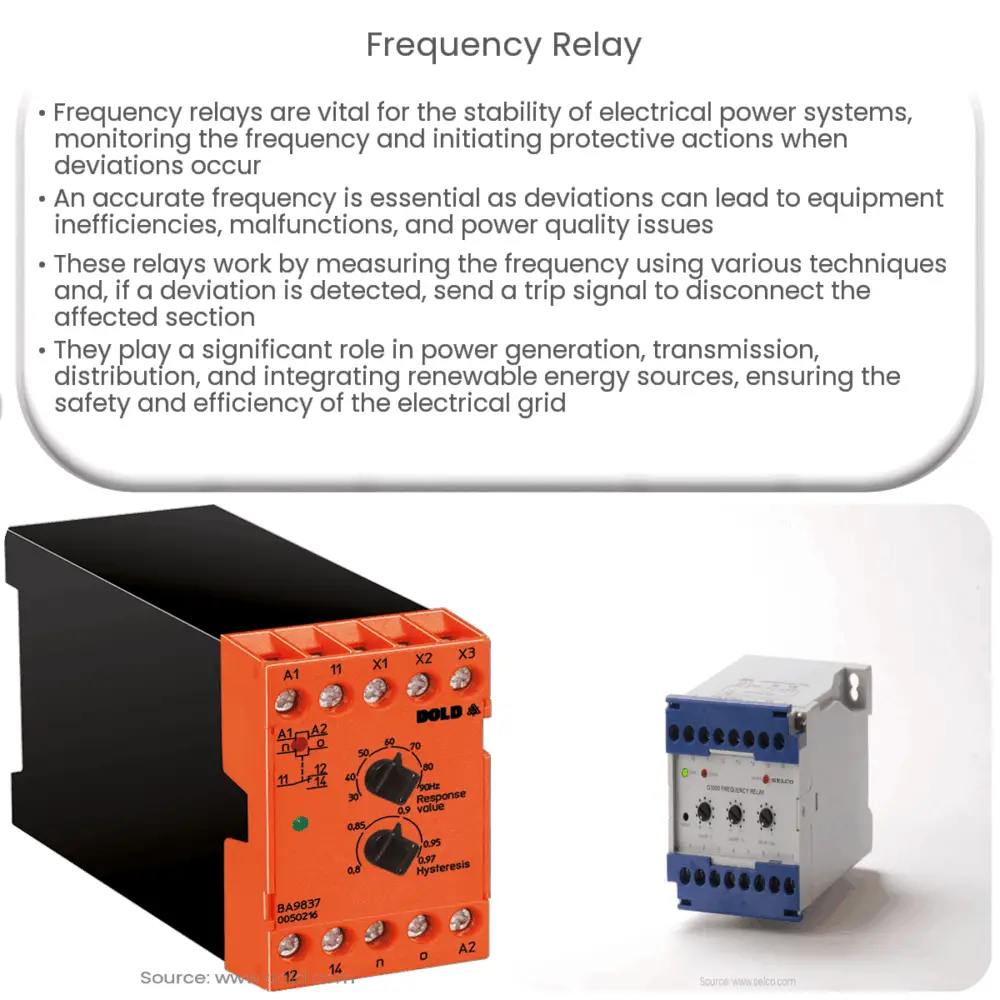A frequency relay is an electrical device that monitors and maintains power system frequency, initiating protective actions to ensure stability.

Understanding Frequency Relay: An Essential Component in Power System Protection
Frequency relay is a crucial element in maintaining the stability of electrical power systems. As the demand for electricity continues to grow, the need for reliable protection schemes becomes paramount. In this article, we will delve into the fundamentals of frequency relay, its applications, and the significance of its role in safeguarding electrical networks.
What is a Frequency Relay?
A frequency relay is an electrical device designed to monitor the frequency of an alternating current (AC) power system and initiate protective actions when the frequency deviates from a pre-defined range. The main objective of a frequency relay is to ensure that the power system operates within safe frequency limits, preventing potential damage to electrical equipment and ensuring the stability and reliability of the power supply.
Why is Frequency Important in Power Systems?
Frequency is a critical parameter in AC power systems as it directly impacts the performance and functionality of electrical equipment. Most electrical devices are designed to operate at a specific frequency, typically 50 or 60 Hz, depending on the region. A deviation from the nominal frequency can lead to undesirable effects, including:
- Reduced efficiency and increased losses in electrical machines
- Overheating and potential failure of equipment
- Malfunctioning of control systems and sensitive electronics
- Unstable voltage levels and power quality issues
To avoid these problems and ensure the safe operation of power systems, it is essential to monitor and maintain frequency within an acceptable range.
How Does a Frequency Relay Work?
A frequency relay employs various techniques to measure the frequency of an AC power system. Some common methods include:
- Direct frequency measurement using a frequency-to-voltage converter
- Indirect frequency measurement by monitoring the voltage or current waveform and calculating the time between zero crossings
- Digital signal processing techniques to analyze the waveform and extract frequency information
When the measured frequency falls outside the pre-defined range, the frequency relay sends a trip signal to circuit breakers or other protective devices, which then disconnect the affected section of the power system. This action isolates the fault or disturbance and helps to prevent further damage to equipment and maintain overall system stability.
Types of Frequency Relays
Frequency relays can be broadly classified into two categories:
- Underfrequency relays: These relays are designed to detect a decrease in frequency, which may be caused by an overload, a sudden loss of generation, or a fault in the power system. Underfrequency relays are typically used to initiate load shedding or generator tripping to restore the balance between supply and demand.
- Overfrequency relays: Overfrequency relays monitor for an increase in frequency, which may occur due to a sudden reduction in load, loss of a large load, or an over-generation situation. In such cases, overfrequency relays can trigger the tripping of generators or other corrective actions to bring the frequency back to normal levels.
Frequency Relay Settings and Coordination
Proper setting and coordination of frequency relays are essential to ensure optimal performance and avoid unnecessary tripping of equipment. The main factors to consider when setting a frequency relay include:
- Nominal system frequency and allowable operating range
- Response time or delay settings to avoid false trips due to transient frequency changes
- Coordination with other protection devices and control systems
Coordination studies and simulations are often performed to verify the correct functioning of the frequency relay and ensure its seamless integration into the overall power system protection scheme.
Applications of Frequency Relays
Frequency relays are widely used in various sectors of the power industry for their effective monitoring and control capabilities. Some common applications include:
- Power generation: Frequency relays help protect generators from damage due to underfrequency or overfrequency conditions, ensuring reliable and efficient operation.
- Transmission and distribution systems: Frequency relays monitor the frequency of the electrical grid and initiate load shedding or generation control actions to maintain stability and prevent blackouts.
- Industrial and commercial facilities: In facilities with sensitive equipment, frequency relays help to maintain the quality of the power supply and protect critical processes from disruptions due to frequency deviations.
- Renewable energy integration: Frequency relays play a crucial role in managing the variable nature of renewable energy sources, such as wind and solar power, ensuring their smooth integration into the grid.
Conclusion
Frequency relay is an indispensable component in power system protection, providing a robust and reliable means to maintain the stability of electrical networks. By continuously monitoring the frequency of the power system and initiating corrective actions when necessary, frequency relays contribute to the overall safety, reliability, and efficiency of the electrical grid. As the demand for electricity continues to grow and new challenges emerge, such as the integration of renewable energy sources, the importance of frequency relay in safeguarding our power systems will only increase.
References
- El-Hawary, M. E. (2011). Electric Power Applications of Fuzzy Systems. Piscataway, NJ: IEEE Press.
- Gers, J. M., & Holmes, E. J. (2000). Protection of Electricity Distribution Networks. London: Institution of Engineering and Technology.
- Horowitz, S. H., & Phadke, A. G. (2008). Power System Relaying. Hoboken, NJ: John Wiley & Sons.
- Schweitzer, E. O., III. (2003). Modern Solutions for Protection, Control, and Monitoring of Electric Power Systems. Pullman, WA: Schweitzer Engineering Laboratories, Inc.

